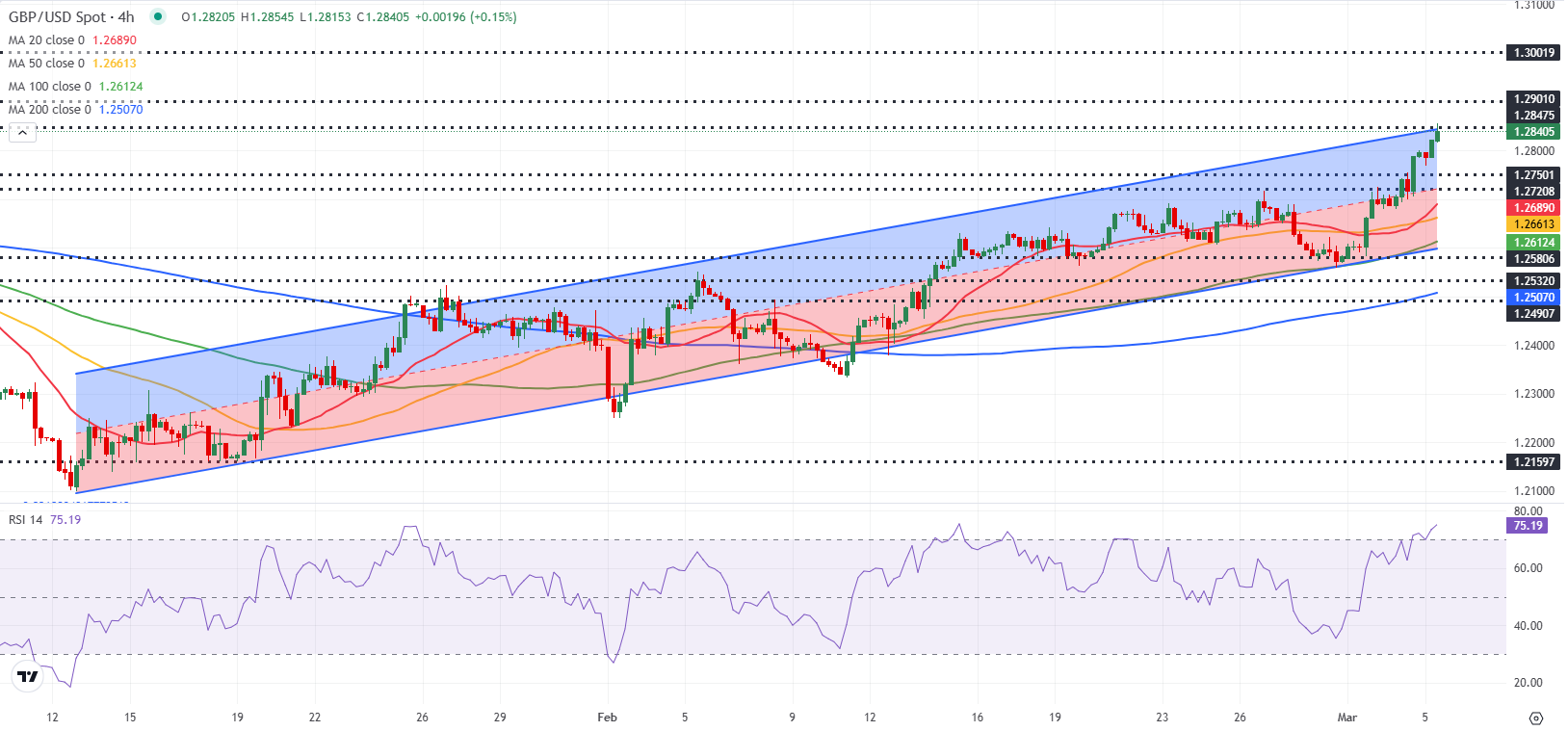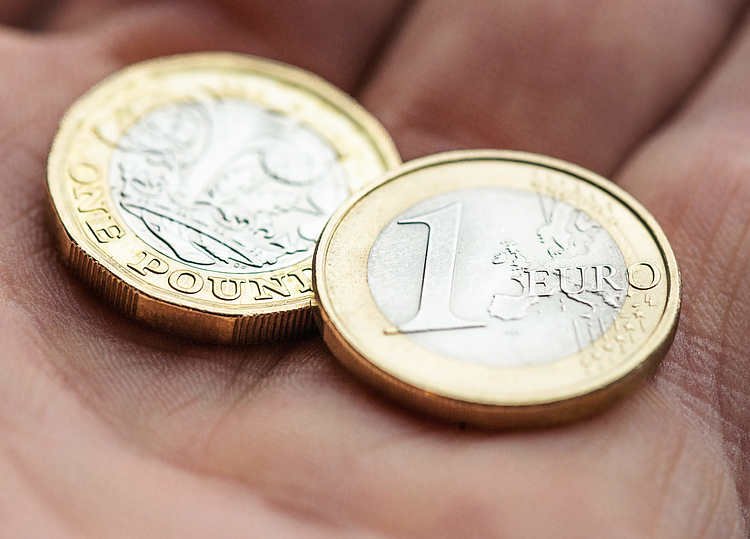- GBP/USD builds on weekly gains and trades comfortably above 1.2800.
- The broad-based selling pressure surrounding the USD fuels the pair’s rally.
- Markets await ADP Employment Change and ISM Services PMI data from the US.
GBP/USD preserves its bullish momentum and trades at its highest level since November 12 near 1.2850 on Wednesday. Investors await February ADP Employment Change and ISM Services PMI data from the US.
British Pound PRICE This week
The table below shows the percentage change of British Pound (GBP) against listed major currencies this week. British Pound was the strongest against the US Dollar.
| USD | EUR | GBP | JPY | CAD | AUD | NZD | CHF | |
|---|---|---|---|---|---|---|---|---|
| USD | -3.00% | -2.04% | -0.87% | -0.41% | -1.22% | -1.41% | -1.82% | |
| EUR | 3.00% | 0.88% | 1.96% | 2.48% | 1.73% | 1.44% | 1.06% | |
| GBP | 2.04% | -0.88% | 1.21% | 1.59% | 0.84% | 0.56% | 0.16% | |
| JPY | 0.87% | -1.96% | -1.21% | 0.67% | -0.32% | -0.52% | -0.97% | |
| CAD | 0.41% | -2.48% | -1.59% | -0.67% | -0.66% | -1.01% | -1.41% | |
| AUD | 1.22% | -1.73% | -0.84% | 0.32% | 0.66% | -0.29% | -0.69% | |
| NZD | 1.41% | -1.44% | -0.56% | 0.52% | 1.01% | 0.29% | -0.40% | |
| CHF | 1.82% | -1.06% | -0.16% | 0.97% | 1.41% | 0.69% | 0.40% |
The heat map shows percentage changes of major currencies against each other. The base currency is picked from the left column, while the quote currency is picked from the top row. For example, if you pick the British Pound from the left column and move along the horizontal line to the US Dollar, the percentage change displayed in the box will represent GBP (base)/USD (quote).
The US Dollar started the week under pressure and continued to weaken against its rivals on Tuesday. In addition to growing concerns over a recession in the US, news of US President Donald Trump possibly rolling back tariffs on Canadian and Mexican imports weighed heavily on the USD.
In the European session on Wednesday, the positive shift seen in risk mood helps GBP/USD continue to push higher. At the time of press, the UK’s FTSE 100 Index was up more than 0.5% on the day and US stock index futures were rising between 0.55% and 0.75%.
Later in the day, Bank of England Governor Andrew Bailey will testify before the Treasury Select Committee. In case Bailey adopts a dovish tone and hints at additional rate cuts, the immediate reaction could limit Pound Sterling’s gains.
In the American session, US ADP Employment Change and ISM Services PMI data for February will be watched closely by market participants.
Investors expect private sector payrolls to rise by 140,000 following the 183,000 increase recorded in January. A positive surprise, with a print above 160,000, could support the USD with the immediate reaction.
The ISM Services PMI is forecast to retreat to 52.6 from 52.8 in January. In case this data comes in below 50 and shows a contraction in the service sector’s business activity, the USD could come under renewed selling pressure and open the door for a leg higher in GBP/USD.
GBP/USD Technical Analysis
The Relative Strength Index (RSI) indicator on the 4-hour chart stays well above 70 and GBP/USD trades near the upper limit of the ascending regression channel, suggesting that the pair could correct lower before extending its uptrend.
On the downside, 1.2800 (static level, round level, 200-day Simple Moving Average) aligns as first support before 1.2750 (static level, former support) and 1.2720 (mid-point of the ascending channel). Looking north, resistances could be spotted at 1.2850 (upper limit of the ascending channel), 1.2900 (static level, round level) and 1.2940 (static level).
Pound Sterling FAQs
The Pound Sterling (GBP) is the oldest currency in the world (886 AD) and the official currency of the United Kingdom. It is the fourth most traded unit for foreign exchange (FX) in the world, accounting for 12% of all transactions, averaging $630 billion a day, according to 2022 data. Its key trading pairs are GBP/USD, also known as ‘Cable’, which accounts for 11% of FX, GBP/JPY, or the ‘Dragon’ as it is known by traders (3%), and EUR/GBP (2%). The Pound Sterling is issued by the Bank of England (BoE).
The single most important factor influencing the value of the Pound Sterling is monetary policy decided by the Bank of England. The BoE bases its decisions on whether it has achieved its primary goal of “price stability” – a steady inflation rate of around 2%. Its primary tool for achieving this is the adjustment of interest rates. When inflation is too high, the BoE will try to rein it in by raising interest rates, making it more expensive for people and businesses to access credit. This is generally positive for GBP, as higher interest rates make the UK a more attractive place for global investors to park their money. When inflation falls too low it is a sign economic growth is slowing. In this scenario, the BoE will consider lowering interest rates to cheapen credit so businesses will borrow more to invest in growth-generating projects.
Data releases gauge the health of the economy and can impact the value of the Pound Sterling. Indicators such as GDP, Manufacturing and Services PMIs, and employment can all influence the direction of the GBP. A strong economy is good for Sterling. Not only does it attract more foreign investment but it may encourage the BoE to put up interest rates, which will directly strengthen GBP. Otherwise, if economic data is weak, the Pound Sterling is likely to fall.
Another significant data release for the Pound Sterling is the Trade Balance. This indicator measures the difference between what a country earns from its exports and what it spends on imports over a given period. If a country produces highly sought-after exports, its currency will benefit purely from the extra demand created from foreign buyers seeking to purchase these goods. Therefore, a positive net Trade Balance strengthens a currency and vice versa for a negative balance.








